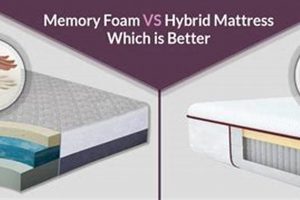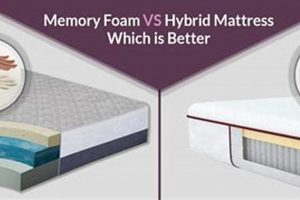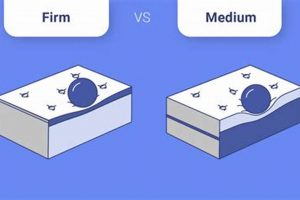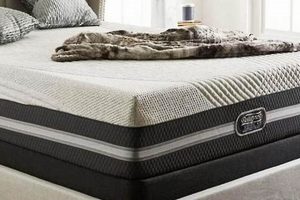The terms designate two common mattress thicknesses. One measures eight inches in depth, while the other measures ten. This difference in height can significantly impact the overall feel, support, and suitability of a mattress for different individuals and sleeping preferences. For example, a heavier individual may find a ten-inch mattress offers more adequate support than an eight-inch version.
Mattress thickness contributes directly to comfort, durability, and suitability for various bed frames and body types. Historically, mattress thickness evolved alongside advancements in materials and manufacturing techniques. Thicker mattresses often incorporate more layers and higher-density materials, potentially enhancing longevity and pressure relief. The choice between these thicknesses represents a key consideration in ensuring optimal sleep quality and postural alignment.
Subsequent sections will delve into a comprehensive comparison of these two mattress types, examining the implications of thickness on factors such as support, comfort, suitability for different sleeping positions, and overall value. Furthermore, considerations for pairing mattresses with specific bed frames and accommodating individual needs will be explored.
Mattress Thickness Selection Guidance
Selecting the appropriate mattress thickness is crucial for optimal sleep quality and long-term comfort. The following tips provide guidance when considering variations in mattress depth.
Tip 1: Assess Body Weight. Individuals with higher body weights generally benefit from thicker mattresses, such as a ten-inch model, which offer enhanced support and prevent excessive sinking. Conversely, lighter individuals may find sufficient support in an eight-inch mattress.
Tip 2: Consider Sleeping Position. Side sleepers often require a thicker mattress to adequately cushion the shoulders and hips, mitigating pressure point discomfort. Back and stomach sleepers may find adequate support with either thickness, depending on individual preference for firmness.
Tip 3: Evaluate Existing Bed Frame. Bed frames with slats or a low profile may require a thicker mattress to achieve a comfortable sleeping height. A thinner mattress on such a frame might result in an uncomfortably low sleeping surface.
Tip 4: Examine Layer Composition. The internal structure of a mattress significantly impacts its performance. A thicker mattress may incorporate additional layers of comfort materials, such as memory foam or latex, enhancing pressure relief and contouring.
Tip 5: Investigate Edge Support. Thicker mattresses tend to offer improved edge support, preventing sagging and facilitating ease of getting in and out of bed. Strong edge support is particularly beneficial for individuals who sleep near the edge of the mattress.
Tip 6: Check for Motion Isolation. If sharing a bed, consider a mattress with good motion isolation properties. Thicker mattresses, especially those with multiple foam layers, often excel at minimizing motion transfer, reducing sleep disturbances.
These tips highlight the importance of carefully evaluating individual needs and preferences when choosing a mattress thickness. Prioritizing factors such as body weight, sleeping position, and bed frame compatibility contributes to a more informed and satisfactory purchasing decision.
The following sections will further explore specific product characteristics and comparative analyses to assist in the ultimate selection of a mattress that aligns with individual sleep requirements.
1. Support and Firmness
Mattress thickness directly correlates with support and firmness characteristics. An eight-inch mattress, due to its reduced profile, typically offers a firmer feel and less conforming support compared to a ten-inch model. This is due to limitations in the number and density of comfort layers that can be incorporated. The reduced material volume in an eight-inch mattress may not adequately distribute weight for heavier individuals, potentially leading to pressure point discomfort and spinal misalignment. Conversely, a ten-inch mattress can accommodate additional layers of high-density foam or support coils, providing enhanced contouring, pressure relief, and overall support. For example, a side sleeper might find that an eight-inch mattress creates excessive pressure on the shoulder and hip, while a ten-inch mattress more effectively cushions these areas.
The relationship between thickness and firmness is not solely determined by height; the specific materials used are also crucial. An eight-inch mattress composed of high-density foam can still offer significant support, albeit with a less plush feel than a ten-inch mattress with softer comfort layers. However, the increased material available in a ten-inch design generally allows for greater design flexibility, enabling manufacturers to create mattresses that cater to a broader range of firmness preferences and sleeping styles. The choice between the two, therefore, hinges on individual weight, sleeping position, and desired level of firmness and support. Consider the example of an individual experiencing lower back pain. An inadequate support system might exacerbate discomfort, while a more supportive mattress, typically a thicker one, could contribute to improved spinal alignment and pain reduction.
In summary, mattress thickness is a primary determinant of support and firmness. While material composition plays a role, the increased volume of a ten-inch mattress typically translates to greater design flexibility and enhanced support capabilities. Eight-inch mattresses offer a firmer, more budget-conscious option, while ten-inch mattresses provide improved contouring and pressure relief, especially beneficial for side sleepers and individuals with specific support requirements. Understanding this relationship is essential for selecting a mattress that promotes optimal spinal alignment and sleep quality.
2. Material Composition
The constituent materials of a mattress significantly influence its performance characteristics, and the choice between an eight-inch and a ten-inch mattress necessitates careful consideration of these materials. Thickness limitations in an eight-inch mattress may restrict the types and combinations of materials used, impacting comfort, support, and durability.
- Foam Density and Type
Higher density foams, such as memory foam or latex, provide enhanced support and durability. A ten-inch mattress can typically accommodate thicker layers of these premium materials compared to an eight-inch model. For instance, a ten-inch mattress might incorporate a three-inch layer of memory foam, whereas an eight-inch version may only allow for a two-inch layer, affecting pressure relief and motion isolation.
- Coil Systems
Innerspring mattresses rely on coil systems for support. Thicker mattresses can utilize more complex coil designs, such as pocketed coils, which provide targeted support and minimize motion transfer. An eight-inch innerspring mattress might employ a simpler, less refined coil system due to space constraints, potentially compromising support and comfort.
- Transition Layers
Transition layers bridge the gap between the support core and comfort layers, enhancing overall feel and preventing a harsh transition. A ten-inch mattress offers greater flexibility in incorporating these transition layers, such as convoluted foam or micro-coils, which can improve pressure distribution and contouring. The absence or reduction of transition layers in an eight-inch mattress may result in a less refined and less comfortable sleeping experience.
- Cover Materials
The mattress cover contributes to breathability, temperature regulation, and overall comfort. While cover material options exist for both eight-inch and ten-inch mattresses, thicker mattresses may benefit from premium cover materials, such as those infused with cooling technologies or enhanced moisture-wicking properties, to further improve sleep quality. The additional thickness can also better showcase quilting and other cover design elements, enhancing aesthetic appeal.
Ultimately, the interplay of these materials within the specific thickness profile of either an eight-inch or ten-inch mattress determines its overall performance. The greater volume available in a ten-inch mattress allows for more sophisticated material combinations and designs, potentially leading to enhanced comfort, support, and durability, albeit at a potentially higher cost. Consumers must carefully evaluate material specifications alongside thickness to make an informed decision aligned with their individual needs and preferences.
3. Sleeping Position Suitability
Sleeping position significantly dictates mattress suitability, and the choice between an eight-inch and ten-inch mattress requires careful consideration of this factor. Different sleeping positions place varying demands on mattress support and pressure relief. Side sleepers, for instance, require a mattress that adequately cushions the shoulders and hips to maintain spinal alignment and prevent pressure point pain. A ten-inch mattress, with its increased thickness, often provides the necessary contouring and support for side sleepers, accommodating the body’s natural curves. Conversely, an eight-inch mattress might prove too firm or lack sufficient cushioning, leading to discomfort and potential misalignment. For example, a side sleeper on an inadequately thick mattress may experience shoulder pain due to concentrated pressure.
Back sleepers generally require a firmer surface to maintain spinal alignment. While an eight-inch mattress can sometimes suffice, the specific materials used are critical. A back sleeper on an eight-inch mattress composed of high-density foam may find adequate support, provided the foam is sufficiently firm. However, a ten-inch mattress offers greater design flexibility, allowing for a combination of support and comfort layers to accommodate individual preferences. Stomach sleepers typically benefit from a firmer mattress to prevent excessive sinking of the hips, which can lead to lower back pain. An eight-inch mattress is often a suitable choice for stomach sleepers, especially if it features a firm support core. However, heavier individuals might still require the added support of a ten-inch mattress, even in the stomach sleeping position. Therefore, an individual’s weight also factors into sleeping position suitability in conjunction with mattress thickness.
In conclusion, mattress thickness plays a crucial role in accommodating different sleeping positions. While an eight-inch mattress may suffice for some back and stomach sleepers, side sleepers typically benefit from the increased cushioning and support provided by a ten-inch mattress. Ultimately, the ideal choice depends on individual preferences, body weight, and the specific materials used in mattress construction. Recognizing the link between sleeping position and mattress thickness is essential for promoting optimal spinal alignment and sleep quality. The challenge lies in balancing individual needs with mattress specifications to achieve optimal comfort.
4. Edge Support
Edge support, a crucial attribute of mattress construction, pertains to the structural reinforcement along the perimeter of a mattress. This feature significantly impacts usable sleeping surface, ease of ingress and egress, and overall mattress durability. The relationship between edge support and mattress thickness, specifically when considering an eight-inch versus a ten-inch mattress, merits careful examination.
- Foam Encasement Thickness
Mattresses often employ foam encasement systems to enhance edge support. A thicker mattress, such as a ten-inch model, typically allows for a more substantial foam encasement, providing greater resistance to compression along the edges. Conversely, an eight-inch mattress, with its limited profile, may feature a thinner or less robust foam encasement, potentially resulting in reduced edge support and a more pronounced “roll-off” sensation. For instance, if two individuals share a bed and sleep near the edge, inadequate edge support in an eight-inch mattress could lead to a feeling of instability and a decreased usable sleeping area.
- Coil System Edge Reinforcement
In innerspring mattresses, edge support is often achieved through the use of reinforced coils along the perimeter. A ten-inch mattress provides more vertical space for incorporating sturdier edge coils or additional layers of support materials around the coil system. An eight-inch innerspring mattress may lack the capacity for such extensive edge reinforcement, potentially compromising long-term durability and edge stability. The difference is comparable to a building with deeper foundations; a thicker mattress allows for a stronger structural framework along its edges.
- Sitting Edge Stability
Edge support directly influences the stability of the mattress when sitting on its edge, a common activity during dressing or preparing for bed. A ten-inch mattress with robust edge support will offer a more stable and supportive seating surface compared to an eight-inch mattress with weaker edge support. Insufficient edge support can lead to premature sagging and deformation of the mattress edge, reducing its lifespan and aesthetic appeal. Imagine the daily wear and tear; the more frequently the edge is used for sitting, the more pronounced the difference in stability will become between the two thicknesses.
- Motion Isolation Implications
While primarily associated with the mattress core, edge support indirectly influences motion isolation. A mattress with strong edge support tends to exhibit more uniform firmness across its entire surface, minimizing motion transfer throughout the bed. Conversely, weak edge support can lead to localized compression and increased motion transfer, particularly near the edges. The benefit to co-sleepers is undeniable; better edge support can contribute to fewer sleep disturbances from a partner’s movements.
In summary, edge support is intrinsically linked to mattress thickness. A ten-inch mattress generally offers greater potential for robust edge reinforcement due to its increased profile and capacity for incorporating thicker foam encasements, sturdier edge coils, and additional support materials. While an eight-inch mattress can provide adequate edge support with careful material selection and construction, it often represents a compromise compared to the enhanced stability and durability afforded by a thicker mattress. Consideration of edge support is crucial for individuals prioritizing usable sleeping surface, ease of movement on and off the bed, and long-term mattress performance.
5. Motion Isolation
Motion isolation, the ability of a mattress to minimize the transfer of movement from one area to another, is a critical consideration, particularly for co-sleepers. The thickness of a mattress, as exemplified by the “8 inch mattress vs 10 inch” comparison, directly influences this characteristic.
- Material Composition and Layering
Thicker mattresses, generally the 10-inch variety in this comparison, often incorporate a greater variety and depth of materials, including specialized motion-isolating foams such as memory foam or latex. These materials absorb and dissipate movement, preventing it from traveling across the mattress surface. An 8-inch mattress, with its reduced profile, may be limited in its ability to incorporate such extensive layers, potentially leading to greater motion transfer. For example, a partner tossing and turning on a thinner mattress may cause more noticeable disturbances compared to a thicker mattress with enhanced motion-isolating properties.
- Coil System Design
In innerspring or hybrid mattresses, the design of the coil system plays a significant role in motion isolation. Pocketed coils, individually wrapped in fabric, are particularly effective at minimizing motion transfer. A 10-inch mattress often allows for the use of more sophisticated pocketed coil systems, providing targeted support and reduced motion propagation. An 8-inch mattress may utilize a more basic coil system with greater interconnection between coils, potentially increasing motion transfer across the surface. A practical demonstration is if one partner gets out of bed, and the other partner barely feels the movement on a ten-inch mattress, but the movement would be significantly more apparent on an eight-inch mattress.
- Density and Firmness
The density and firmness of the mattress materials also contribute to motion isolation. Denser foams tend to absorb more energy and reduce motion transfer. Softer mattresses, while providing enhanced comfort, may exhibit greater motion transfer due to their increased responsiveness to movement. The ideal balance between density, firmness, and motion isolation often depends on the specific combination of materials used and the overall mattress design. For instance, a firmer eight-inch mattress made of high-density foam might isolate motion more effectively than a softer ten-inch mattress with less dense materials.
- Edge Support Structure
While primarily focused on edge stability, the edge support structure can indirectly impact motion isolation. A mattress with weak edge support may exhibit greater compression and deformation along the edges, potentially increasing motion transfer to adjacent areas. A thicker mattress with robust edge support, typically the 10-inch option, tends to maintain more uniform firmness across its entire surface, minimizing motion propagation from one side of the bed to the other. This effect is subtle but contributes to the overall sleep experience for co-sleepers.
The selection between an 8-inch and 10-inch mattress entails a careful assessment of motion isolation capabilities. The superior depth and layering available in a 10-inch mattress often allow for improved motion isolation through more sophisticated material combinations and coil system designs. However, an 8-inch mattress can still provide adequate motion isolation with careful material selection, emphasizing high-density foams and individually pocketed coils. Ultimately, the ideal choice depends on individual needs and preferences, particularly for couples seeking to minimize sleep disturbances caused by partner movement.
6. Bed Frame Compatibility
Bed frame compatibility represents a critical aspect of mattress selection, significantly influenced by mattress thickness. The choice between an eight-inch and ten-inch mattress necessitates careful consideration of existing or intended bed frame dimensions and design. Incompatibility can lead to aesthetic imbalances, compromised support, and potential safety hazards.
- Platform Bed Considerations
Platform beds, characterized by a solid or slatted surface eliminating the need for a box spring, often benefit from thicker mattresses. A ten-inch mattress provides adequate height for comfortable ingress and egress, while an eight-inch mattress might result in a lower sleeping surface, potentially posing challenges for individuals with mobility limitations. Furthermore, a thicker mattress on a platform bed offers a more substantial visual presence, contributing to a balanced aesthetic.
- Bed Frame Height and Headboard Visibility
Bed frame height, particularly in conjunction with a headboard, directly impacts the visible portion of the headboard. An eight-inch mattress on a tall bed frame may obscure a significant portion of the headboard, diminishing its aesthetic appeal. Conversely, a ten-inch mattress can elevate the sleeping surface, ensuring the headboard remains prominently displayed. The selection should align with the desired visual balance between the bed frame, mattress, and headboard.
- Box Spring Compatibility
Traditional bed frames designed to accommodate a box spring require careful consideration of mattress thickness. An eight-inch mattress paired with a standard box spring may result in an excessively low sleeping surface. Conversely, a ten-inch mattress combined with a high-profile box spring could create an uncomfortably elevated sleeping surface. The optimal combination depends on individual height preferences and the overall room aesthetic.
- Slatted Bed Frame Support
Slatted bed frames rely on evenly spaced slats to provide mattress support. The spacing and thickness of these slats can influence the performance of both eight-inch and ten-inch mattresses. Widely spaced slats may not provide adequate support for thinner mattresses, potentially leading to sagging and premature wear. A thicker mattress, with its greater structural integrity, can often better withstand wider slat spacing. However, regardless of thickness, ensuring the slats are robust and properly spaced is crucial for mattress longevity.
The compatibility between a mattress and bed frame extends beyond mere dimensions. Aesthetically, the combined height and visual weight must complement the room’s overall design. Functionally, the bed frame must provide adequate support to prevent premature mattress degradation. Careful assessment of these factors ensures the selection of an eight-inch or ten-inch mattress harmonizes with the chosen bed frame, optimizing both comfort and longevity.
7. Cost Considerations
The financial implications associated with mattress selection represent a significant factor for consumers. The price differential between an eight-inch and a ten-inch mattress often reflects variations in material quantity, manufacturing complexity, and feature sets. A comprehensive understanding of these cost drivers is essential for making an informed purchasing decision.
- Raw Material Quantity and Expense
A ten-inch mattress, by virtue of its increased thickness, inherently requires a greater quantity of raw materials, including foam, coils, and fabric. These added materials directly contribute to higher manufacturing costs, which are subsequently reflected in the retail price. For instance, a mattress incorporating multiple layers of memory foam will command a premium compared to a simpler design utilizing fewer specialized materials. The cost of raw materials often correlates directly with mattress thickness, particularly when comparing similar construction techniques.
- Manufacturing Complexity and Labor
The construction of a ten-inch mattress typically involves more intricate manufacturing processes compared to an eight-inch counterpart. The addition of extra layers and specialized components necessitates more labor and specialized machinery, increasing production expenses. For example, a mattress featuring individually wrapped coils requires a more complex assembly process than one using a traditional interconnected coil system. These added complexities translate to higher manufacturing costs and, consequently, a higher retail price.
- Feature Sets and Premium Options
Thicker mattresses often incorporate enhanced features and premium options, such as advanced cooling technologies, specialized edge support systems, and organic or hypoallergenic materials. These additions contribute to improved comfort, durability, and overall sleep quality, but also command a higher price point. A ten-inch mattress may offer features unavailable in a thinner model, justifying the price differential for consumers prioritizing enhanced performance and longevity.
- Long-Term Value and Durability
While an eight-inch mattress may present a lower initial cost, the long-term value must also be considered. A thicker, higher-quality mattress often exhibits greater durability and resistance to sagging or deformation, potentially extending its lifespan and reducing the need for premature replacement. Although the upfront investment may be higher for a ten-inch mattress, its extended lifespan can translate to a lower cost per year of use, representing a more economical choice in the long run. The consumer must weigh the initial cost against the anticipated lifespan and performance characteristics of each option.
Ultimately, the cost considerations associated with an eight-inch versus a ten-inch mattress extend beyond the initial purchase price. Factors such as material quantity, manufacturing complexity, feature sets, and long-term durability all contribute to the overall value proposition. A thorough assessment of these elements enables consumers to make a financially sound decision aligned with their individual needs and budget constraints.
Frequently Asked Questions
The following addresses commonly asked questions regarding the distinctions between eight-inch and ten-inch mattresses, providing objective insights to aid in informed decision-making.
Question 1: What are the primary differences in support offered by an 8 inch mattress vs 10 inch mattress?
The primary difference lies in the potential for increased material density and layering in the 10-inch mattress. This often translates to enhanced support, particularly for heavier individuals or those requiring more substantial spinal alignment. An 8-inch mattress may offer sufficient support for lighter individuals but may compromise support for those with greater weight or specific orthopedic needs.
Question 2: Does mattress thickness directly impact motion isolation capabilities?
Yes, mattress thickness influences motion isolation. Thicker mattresses, such as 10-inch models, typically allow for the incorporation of more sophisticated motion-isolating materials, like individually pocketed coils or specialized foam layers. This results in reduced motion transfer compared to an 8-inch mattress, which may have limited capacity for such advanced features.
Question 3: How does sleeping position influence the optimal mattress thickness?
Sleeping position is a key determinant. Side sleepers often benefit from the increased cushioning of a 10-inch mattress to alleviate pressure on the shoulders and hips. Back and stomach sleepers may find adequate support in either thickness, although individual preferences for firmness should also be considered.
Question 4: Are there specific bed frames for which an 8 inch mattress vs 10 inch mattress is better suited?
Platform beds generally pair well with thicker mattresses, like 10-inch models, for optimal height and aesthetic balance. Traditional bed frames designed for use with a box spring require careful consideration to ensure the combined height is neither too low nor too high. Eight-inch mattresses may be more suitable for low-profile bed frames to achieve a comfortable sleeping height.
Question 5: Does a thicker mattress always equate to greater durability?
While thickness can contribute to durability, it is not the sole determining factor. Material quality, construction techniques, and usage patterns also significantly impact mattress lifespan. A well-constructed 8-inch mattress using high-quality materials can potentially outlast a poorly constructed 10-inch mattress.
Question 6: How does the cost typically compare between an 8 inch mattress vs 10 inch mattress of similar construction?
A 10-inch mattress generally commands a higher price due to the increased quantity of materials required. However, promotional offers, brand reputation, and retailer markups can also influence pricing. Comparing mattresses of similar construction from the same brand provides the most accurate assessment of the cost differential attributed solely to thickness.
In summary, selecting the appropriate mattress thickness necessitates a thorough evaluation of individual needs, sleeping preferences, and budget considerations. Thickness is just one factor; construction quality is important too.
The following section will provide a comprehensive comparison table, highlighting the key features and benefits of each mattress thickness.
Concluding Assessment
This exploration of “8 inch mattress vs 10 inch” has illuminated significant differences in support, motion isolation, bed frame compatibility, and cost. A ten-inch mattress often presents enhanced support and motion isolation due to increased material volume and layering capabilities. Conversely, an eight-inch mattress provides a firmer, more budget-conscious option, potentially suitable for lighter individuals or specific bed frame configurations. Material composition and construction quality further influence the performance and longevity of both options.
The ultimate selection necessitates a careful evaluation of individual needs and preferences, considering body weight, sleeping position, and desired firmness levels. Consumers are encouraged to thoroughly assess mattress specifications and, where possible, engage in in-person testing to determine the most appropriate choice. Prioritizing informed decision-making ensures optimal sleep quality and long-term satisfaction.



![Novaform vs. Casper Mattress: Which is Best [Year]? Organic & Natural Mattress Buyer’s Guide: Non-Toxic Sleep Solutions Novaform vs. Casper Mattress: Which is Best [Year]? | Organic & Natural Mattress Buyer’s Guide: Non-Toxic Sleep Solutions](https://mattressworldpa.com/wp-content/uploads/2025/07/th-1065-300x200.jpg)



